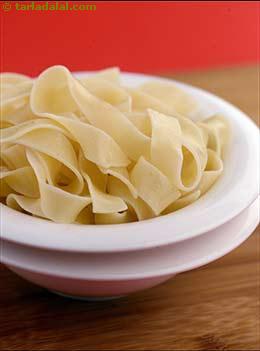" Both fresh and dried versions are used to make fettuccine Alfredo, a quintessential dish which layers fettuccine pasta in a thick, creamy sauce. To make the dish, cooks toss freshly cooked pasta with heavy cream and a mixture of cheeses such as Parmesan and Romano. Fettuccine Alfredo is typically finished with lavish amounts of fresh ground salt and pepper.
" Deliciously simple, yet very impressive seafood pasta dish with cream and Parmesan cheese.
" Light, very healthy and overwhelmingly green, this is a vegetarian delight broccoli flowerets, oil, sesame seed, toasted, fettuccine, broken up, Parmesan cheese.
" Chocolate Fettuccine with Vanilla Sauce and Strawberries Recipe
" Drain the pasta thoroughly and transfer to warm soup plates. Top with sauce and use two forks to gently lift the pasta and allow the sauce to coat it. Spoon the berries on top, garnish with mint leaves and serve immediately.
How to store fettuccine, flat ribbon pasta
Store it, unopened, in a cool, dry cupboard for six to eight months or as per the expiry date. Dried, fresh, and cooked pasta need to be stored in different ways. Fresh pasta will keep for 1-2 days in the refrigerator and can also be frozen. Stuffed pasta or fresh pasta made with eggs will keep for 1 day in the refrigerator or 2 months in the freezer. Cooked pasta will keep for 3-5 days in the fridge or freezer. When refrigerating or freezing cooked pasta, be sure it is stored in a well sealed container so that it does not absorb any odours.
Cooked fettuccine

Boil plenty of water in a large pan with 1 tsp of salt and 1 tsp of oil. Add the fettuccine to the boiling water by adding a few at a time. Cook uncovered, stirring occasionally and gently until the fettuccine is tender. Cooking times may vary with the size and the thickness of the fettuccine. Immediately drain the cooked fettuccine into a sieve or a colander. Transfer to a bowl of cold water to refresh it. Drain again and keep aside. If the fettuccine is not to be used immediately, add 1 tbsp of oil to it and toss it.
Green fettuccine
Green Fettuccine is made by adding boiled and pureed spinach to the pasta dough and then make the fettuccine as usual. Green fettuccine is found on the same aisle as other pasta products. It is dried wide noodle pasta mixed with fresh spinach leaves, which imparts the green colour. This variety of pasta not only enhances the look of the dish but also is of great nutritive significance.
Having Spinach in it, serves as a scrumptious and colorful appealing dish. It goes well with all veggies, just experiment with your choice or favorites and cook with minimal spice for best flavour. Just the plain green fettuccine tastes immensely wonderful with cheese topped and a little bit of mixed herbs sprinkled.